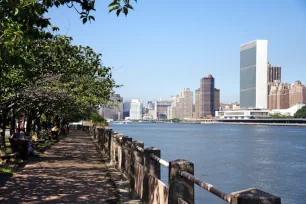Roosevelt Island was once known for its prisons and asylums, but it is now regarded as a fashionable place to live, situated in the middle of the East River, right between Manhattan and Queens.
Its History

Originally called Minnahanock by the Native Americans who resided there, the piece of land now known as Roosevelt Island had a number of other names as well, including Hogs’ Island (1637-1685), Blackwell’s Island (1686-1921) – after the Blackwell Farmhouse, and Welfare Island (1921-1973) – for the hospitals and asylums that were established here.
Prisons and Asylums
The island is best known as the site of a number of prisons and asylums. The prisons, including Welfare Penitentiary, housed a number of infamous personalities, including actress Mae West, who in 1927 was arrested for lewd behavior; mobster Dutch Schultz; and blues singer Billy Holliday, who was incarcerated after she was caught soliciting.

The asylums on the island were known for being particularly cruel and badly run. Author Charles Dickens wrote about them back in the mid 1800s, and journalist Nellie Bly went undercover at the Women’s Lunatic Asylum in order to expose the horrific goings-on there.
Roosevelt Island becomes Residential
Roosevelt Island’s transformation from a secluded island for convicts and patients into a residential neighborhood started in 1973 with the development of Northtown, later followed with Southtown, which has been credited with bringing new retail opportunities to the island, including a number of restaurants.

Another major development on the island is the creation of a new state-of-the-art science and computer engineering campus, occupying an area of some 2.1 million square feet or almost twenty hectares.
Roosevelt Island has become a tony place to live, and it is now home to a number of celebrities and quite a few foreign diplomats who enjoy close proximity to the UN by living on the island.

Sights
The first impression of Roosevelt may be one of a bland and dull neighborhood, but there are quite a few interesting landmarks and parks on the island. And if anything, the riverside promenade that stretches around the island is well worth a visit on its own as it allows for great views of Manhattan, the East River and Queens.
Octagon
Some of the island’s old landmarks have enjoyed restorations. These include “The Octagon”. This national landmark was originally built in 1839 as the administrative center of the New York Lunatic Asylum. The octagonal building is now integrated into the “Octagon Development”, a high-end apartment complex that was the first “green” building on Roosevelt Island.
Lighthouse
The Blackwell Lighthouse, another historic landmark, can be seen on the northern tip of Roosevelt Island. The octagonal-shaped lighthouse was built in 1872 by James Renwick Jr., who designed it in a Gothic style. The 50 ft / 15 meter tall lighthouse was in operation until around 1940.


Southpoint Park
The southernmost part of Roosevelt Island has been developed into Southpoint Park, a park with a natural layout planted with wild plants and flowers native to the New York City region. The park is divided into themed ‘green rooms’.
The park encompasses the Renwick Ruins, the ruins of a smallpox hospital designed by James Renwick Jr., who is best known as the architect of the St. Patrick’s Cathedral. The hospital opened in 1859 and was made from stones quarried on the island by convicts. Another landmarked building on Southpoint Park is the Strecker Memorial Laboratory, built in 1909 as the first center for the study of pathology in the nation.
Franklin Delano Roosevelt Memorial Park
The southern tip of the island has been transformed into the Franklin D. Roosevelt Four Freedoms Park, a modern formal park that honors former president and governor of New York Franklin D. Roosevelt. The name of the park refers to Roosevelt’s Four Freedoms Speech, a famous speech that he delivered on January 6, 1941.
Plans for the memorial were made as early as in 1973, when the island was renamed in honor of Franklin D. Roosevelt. Due to circumstances, construction of the park only started in 2010.
The park was laid out following plans created by Louis I. Kahn shortly before the architect suddenly died in 1974. The triangular shape of the park with its tree-lined grassy expanse creates a vista that culminates in a rectangular memorial with a colossal sculpture of Roosevelt’s head. The bronze head is a work of American sculptor Jo Davidson, who modeled it in 1933. The back of the monument is inscribed with an excerpt from Roosevelt’s Four Freedoms Speech.

Getting Around
Roosevelt Island sits directly under the Queensboro Bridge but is not accessible from the bridge, and much of the island remains automobile-free, as was originally intended. To get around, residents can hop the Roosevelt Island Tram. The aerial tramway was created in 1976 as a shuttle between the island and midtown Manhattan. Built by a Swiss company, the tram is able to hold 125 persons. The tram rises to a height of 250 ft (76 meters) from where passengers have a great view over Midtown.
Alternatively, you can take the subway from the island (it’s the deepest subway station in New York) to Manhattan or Queens. In addition, a small, inexpensive shuttle takes residents from a number of apartment buildings to the subway or tram stop.

